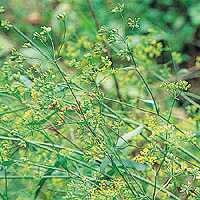
A-Z Indexes Food Health Guides
Health News |
BupleurumFind ProductsAlso indexed as:Bupleurum chinense, Bupleurum falcatum  © Martin Wall © Martin WallBotanical names: Bupleurum chinense, Bupleurum falcatumParts Used & Where GrownThese Asian plants are part of the Apiaceae (Umbelliferae) family, and resemble dill or fennel. However, bupleurum has long thin leaves rather than the lacy appearance of fennel and dill leaves. The Chinese name for bupleurum, chai hu, means “kindling of the barbarians.” The origin of this name is unclear. The roots of the plant are used in herbal medicine.
Our proprietary “Star-Rating” system was developed to help you easily understand the amount of scientific support behind each supplement in relation to a specific health condition. While there is no way to predict whether a vitamin, mineral, or herb will successfully treat or prevent associated health conditions, our unique ratings tell you how well these supplements are understood by the medical community, and whether studies have found them to be effective for other people. For over a decade, our team has combed through thousands of research articles published in reputable journals. To help you make educated decisions, and to better understand controversial or confusing supplements, our medical experts have digested the science into these three easy-to-follow ratings. We hope this provides you with a helpful resource to make informed decisions towards your health and well-being. This supplement has been used in connection with the following health conditions:
Traditional Use (May Not Be Supported by Scientific Studies)Bupleurum has been used in Traditional Chinese Medicine for thousands of years to help relieve numerous conditions. Most particularly, infections with fever, liver problems, indigestion, hemorrhoids, and uterine prolapse.1 Bupleurum is a key ingredient in the formula known as sho-saiko-to. This is a Japanese kampo or traditional herbal medicine formula based on the traditional Chinese formula xiao-chai-hu-tang. In English, it has been called minor bupleurum formula. Bupleurum makes up 16% of the formula for sho-saiko-to (see below for the complete contents of the formula). Results reported for sho-saiko-to cannot be attributed solely to bupleurum because the other herbs in the formula also contribute.2 Sho-saiko-to (xao-chai-hu-tang or minor bupleurum formula) contains the following:
Copyright © 2025 TraceGains, Inc. All rights reserved. Learn more about TraceGains, the company. The information presented by TraceGains is for informational purposes only. It is based on scientific studies (human, animal, or in vitro), clinical experience, or traditional usage as cited in each article. The results reported may not necessarily occur in all individuals. Self-treatment is not recommended for life-threatening conditions that require medical treatment under a doctor's care. For many of the conditions discussed, treatment with prescription or over the counter medication is also available. Consult your doctor, practitioner, and/or pharmacist for any health problem and before using any supplements or before making any changes in prescribed medications. Information expires December 2025. |
